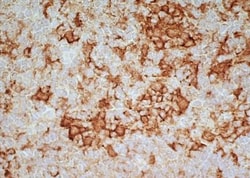Promotional price valid on web orders only. Your contract pricing may differ. Interested in signing up for a dedicated account number?
Learn More
Learn More
Siglec-1/CD169 Antibody (ED3) - BSA Free, Novus Biologicals™


Mouse Monoclonal Antibody
Supplier: Novus Biologicals NB100653010.025MG
Description
Siglec-1/CD169 Monoclonal specifically detects Siglec-1/CD169 in Rat samples. It is validated for Flow Cytometry, Immunohistochemistry, Immunocytochemistry/Immunofluorescence, Immunoprecipitation, Immunohistochemistry-Frozen.Specifications
| Siglec-1/CD169 | |
| Monoclonal | |
| 0.5 mg/mL | |
| Flow Cytometry 1:500, Immunohistochemistry 1:10-1:500, Immunocytochemistry/Immunofluorescence 1:10-1:500, Immunoprecipitation 1:10-1:500, Immunohistochemistry-Frozen 1:50-1:250 | |
| CD169, FLJ00051, sialic acid binding Ig-like lectin 1, sialoadhesin, sialoadhesin | |
| Mouse | |
| Protein A purified | |
| RUO | |
| 6614 | |
| Rat | |
| Purified |
| Flow Cytometry, Immunocytochemistry, Immunofluorescence, Immunohistochemistry, Immunoprecipitation, Immunohistochemistry (Frozen) | |
| ED3 | |
| Unconjugated | |
| PBS (pH 7.4) with 0.09% Sodium Azide | |
| SIGLEC1 | |
| Rat Spleen cell homogenate | |
| 0.025 mg | |
| Primary | |
| NB100-65301 recognizes the rat CD169 cell surface antigen, a 185kD molecule expressed by macrophages, predominately confined to lymphoid organs only. Monocytes and granulocytes are negative. No other cell types are positive. The most conspicious property of ED3 is it stains marginal zone macrophages and marginal metallophils in the spleen very strongly. Furthermore, macrophages in (auto-immune) diseased tissues express the ED3 antigen. In healthy tissue no expression occurs. CD169 is a receptor for glycoconjugates containing sialic acid. | |
| Store at 4C short term. Aliquot and store at -20C long term. Avoid freeze-thaw cycles. | |
| IgG2a |
Product Content Correction
Your input is important to us. Please complete this form to provide feedback related to the content on this product.
Product Title
For Research Use Only
Spot an opportunity for improvement?Share a Content Correction
